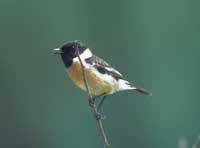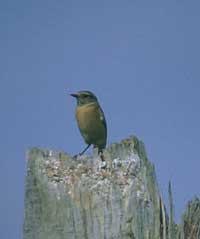Pichichón head, say and be

The name “Pitxartxar” is not of those who have simply put on. Catalans, for example, know this same bird as jewelry and the English call it chat. All of them are names created imitating the snap that the bird makes, that is, they are onomatopédicos, and in Basque we have a lot of names of this type. Among the birds we can mention pyripium, txirriskilla, txepetxa, txiio, garraztarro or the cuckoo itself.
The author of this curious song is a burnished pitcher ("Saxicola torquata"), insectivorous bird 13 cm in length and 15 grams in weight. The male has black head and back, white bishopric, brown-reddish chest and a neck adorned with white scars on both sides. The female, on the other hand, has a similar color distribution but with slower colors. The young are similar to the females, but they are dressed in painted plumage. Thanks to this beautiful plumage it is an easily recognizable bird and, in case of confusion, it would probably mix with another kind of vase, the brown vase ( Saxicola rubetra). The latter, unlike black heads, has a white eyebrow and white spots on the tail, among others. However, while the first is abundant, the second is much scarcer and is only raised in Aralar, Lokiz, Urbasa, Llanadas Alavesas and the west of Lapurdi.

In addition to a special garment, it has special behaviors that can help us identify the stubborn jugs. It is used to resting on electricity cables, fence between pastures, bush tips, etc. Therefore, and by showing little fear to the human being and walking through wide areas, it is not difficult to see it well. When flying from one side to the other it goes very close to the earth and makes short flights. Finally, it is interesting to know the habit of constantly stirring the tails and slopes and, of course, the famous so-called “pii-txar-txar” that we mentioned at the beginning.
As for its habitat and as already mentioned, it likes open spaces; it inhabits grasslands with argomal, heath and shrubs, scrubland lands and herbaceous forests, from sea level to a height above 1,400 meters.
At the end of March and driven by the passion of spring, the male, dressed in the most discreet plumage, begins to defend the limits of a territory of between 1 and 2 hectares of whistles and membranes. To do this you can start flying with each fin stroke by making an chio or singing for some striking place. But since the male is a polygamous and at a reproductive time can be equated with several females, it will have as many territories as females and, of course, is saturated with care tasks. That's why this is the best time to see the jug, as it sings in very prominent places. From time to time, in one of the appetizers, we can see the special song of the flute to attract the female. As the female approaches they begin to play at the wedding and the male flies at full speed behind the female.

From the month of April and well hidden in some corner or vegetable section that no one finds, the female builds a nest in the form of a container. Sometimes he places it in the middle of a scrub and opens a tunnel between the branches to reach it without being seen. In addition to moss, rooting, feather and grass, use the hair to calm the interior. At the end of these works she lays between 4 and 6 blue eggs adorned with brown-reddish pints. The 13-15 day coat also corresponds to the female, while the male defends the territory and provides food for reproduction (or reproduction).
The two weeks that go from birth to nesting of the offspring are relentlessly for the parents, since to feed the insatiable chickens they have to hunt constantly. To realize this enormous effort, here is a quite significant fact: In a single day parents make more than 300 trips to take to their nest! In addition, at the beginning of the first txitaldia early, usually also the second and sometimes the third. It is therefore necessary to take into account the piles of displacements that the jugs have had to make when the reproductive time ends.

Miko and fine legs show that the spiked jug feeds on bugs. Fine watch, insects, spiders, males, snails, etc., as you discover something, to descend from top to bottom and catch it with the beak. In winter, however, due to the scarce abundance of these foods, it explodes fruits and seeds as food. For the same reason, many of the members of the breeding species in central Europe head south in winter. Our vases, on the other hand, seem sedentary and therefore remain in the surroundings throughout the year.
This bird lives in central and southern Europe, northwest Africa and large areas of Asia. It is the most common nesting agent in the Iberian Peninsula, north and west. From the shore of the sea you reach the meadows of the mountain and is a species practically localizable in the area of the Ebro, except in the high mountain and in areas completely covered with forests. It will not cost you much to meet this bird, therefore be attentive that: If he says “bad”, know that it is so joyful.
Jug Species: Saxicola torquata Family: muszikapidos Order: paseriformes Class: birds |





